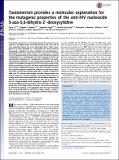| dc.contributor.author | Li, Deyu | |
| dc.contributor.author | Fedeles, Bogdan I. | |
| dc.contributor.author | Singh, Vipender | |
| dc.contributor.author | Peng, Chunte Sam | |
| dc.contributor.author | Silvestre, Katherine J. | |
| dc.contributor.author | Simi, Allison K. | |
| dc.contributor.author | Simpson, Jeffrey H. | |
| dc.contributor.author | Essigmann, John M. | |
| dc.contributor.author | Tokmakoff, Andrei | |
| dc.date.accessioned | 2015-02-05T16:54:25Z | |
| dc.date.available | 2015-02-05T16:54:25Z | |
| dc.date.issued | 2014-07 | |
| dc.date.submitted | 2014-03 | |
| dc.identifier.issn | 0027-8424 | |
| dc.identifier.issn | 1091-6490 | |
| dc.identifier.uri | http://hdl.handle.net/1721.1/93785 | |
| dc.description.abstract | Viral lethal mutagenesis is a strategy whereby the innate immune system or mutagenic pool nucleotides increase the error rate of viral replication above the error catastrophe limit. Lethal mutagenesis has been proposed as a mechanism for several antiviral compounds, including the drug candidate 5-aza-5,6-dihydro-2′-deoxycytidine (KP1212), which causes A-to-G and G-to-A mutations in the HIV genome, both in tissue culture and in HIV positive patients undergoing KP1212 monotherapy. This work explored the molecular mechanism(s) underlying the mutagenicity of KP1212, and specifically whether tautomerism, a previously proposed hypothesis, could explain the biological consequences of this nucleoside analog. Establishing tautomerism of nucleic acid bases under physiological conditions has been challenging because of the lack of sensitive methods. This study investigated tautomerism using an array of spectroscopic, theoretical, and chemical biology approaches. Variable temperature NMR and 2D infrared spectroscopic methods demonstrated that KP1212 existed as a broad ensemble of interconverting tautomers, among which enolic forms dominated. The mutagenic properties of KP1212 were determined empirically by in vitro and in vivo replication of a single-stranded vector containing a single KP1212. It was found that KP1212 paired with both A (10%) and G (90%), which is in accord with clinical observations. Moreover, this mutation frequency is sufficient for pushing a viral population over its error catastrophe limit, as observed before in cell culture studies. Finally, a model is proposed that correlates the mutagenicity of KP1212 with its tautomeric distribution in solution. | en_US |
| dc.description.sponsorship | National Institutes of Health (U.S.) (Grant P01 CA26731) | en_US |
| dc.description.sponsorship | National Institutes of Health (U.S.) (Grant P30 ES002109) | en_US |
| dc.description.sponsorship | National Institutes of Health (U.S.) (Grant R37 CA080024) | en_US |
| dc.description.sponsorship | National Science Foundation (U.S.) (Grant CHE-1212557) | en_US |
| dc.description.sponsorship | National Institutes of Health (U.S.). Massachusetts Institute of Technology. Laser Biomedical Research Center (Grant P41 EB015871) | en_US |
| dc.description.sponsorship | National Institutes of Health (U.S.) (Training Grant T32 ES007020) | en_US |
| dc.description.sponsorship | National Science Foundation (U.S.) (Award CHE-9808061) | en_US |
| dc.language.iso | en_US | |
| dc.publisher | National Academy of Sciences (U.S.) | en_US |
| dc.relation.isversionof | http://dx.doi.org/10.1073/pnas.1405635111 | en_US |
| dc.rights | Article is made available in accordance with the publisher's policy and may be subject to US copyright law. Please refer to the publisher's site for terms of use. | en_US |
| dc.source | National Academy of Sciences (U.S.) | en_US |
| dc.title | Tautomerism provides a molecular explanation for the mutagenic properties of the anti-HIV nucleoside 5-aza-5,6-dihydro-2'-deoxycytidine | en_US |
| dc.type | Article | en_US |
| dc.identifier.citation | Li, Deyu, Bogdan I. Fedeles, Vipender Singh, Chunte S. Peng, Katherine J. Silvestre, Allison K. Simi, Jeffrey H. Simpson, Andrei Tokmakoff, and John M. Essigmann. “Tautomerism Provides a Molecular Explanation for the Mutagenic Properties of the Anti-HIV Nucleoside 5-Aza-5,6-Dihydro-2’-Deoxycytidine.” Proceedings of the National Academy of Sciences 111, no. 32 (July 28, 2014): E3252–E3259. | en_US |
| dc.contributor.department | Massachusetts Institute of Technology. Center for Environmental Health Sciences | en_US |
| dc.contributor.department | Massachusetts Institute of Technology. Department of Biological Engineering | en_US |
| dc.contributor.department | Massachusetts Institute of Technology. Department of Chemistry | en_US |
| dc.contributor.mitauthor | Li, Deyu | en_US |
| dc.contributor.mitauthor | Fedeles, Bogdan I. | en_US |
| dc.contributor.mitauthor | Singh, Vipender | en_US |
| dc.contributor.mitauthor | Peng, Chunte Sam | en_US |
| dc.contributor.mitauthor | Silvestre, Katherine J. | en_US |
| dc.contributor.mitauthor | Simi, Allison K. | en_US |
| dc.contributor.mitauthor | Simpson, Jeffrey H. | en_US |
| dc.contributor.mitauthor | Essigmann, John M. | en_US |
| dc.contributor.mitauthor | Tokmakoff, Andrei | en_US |
| dc.relation.journal | Proceedings of the National Academy of Sciences of the United States of America | en_US |
| dc.eprint.version | Final published version | en_US |
| dc.type.uri | http://purl.org/eprint/type/JournalArticle | en_US |
| eprint.status | http://purl.org/eprint/status/PeerReviewed | en_US |
| dspace.orderedauthors | Li, Deyu; Fedeles, Bogdan I.; Singh, Vipender; Peng, Chunte S.; Silvestre, Katherine J.; Simi, Allison K.; Simpson, Jeffrey H.; Tokmakoff, Andrei; Essigmann, John M. | en_US |
| dc.identifier.orcid | https://orcid.org/0000-0002-8241-4834 | |
| dc.identifier.orcid | https://orcid.org/0000-0002-2196-5691 | |
| mit.license | PUBLISHER_POLICY | en_US |
| mit.metadata.status | Complete | |
